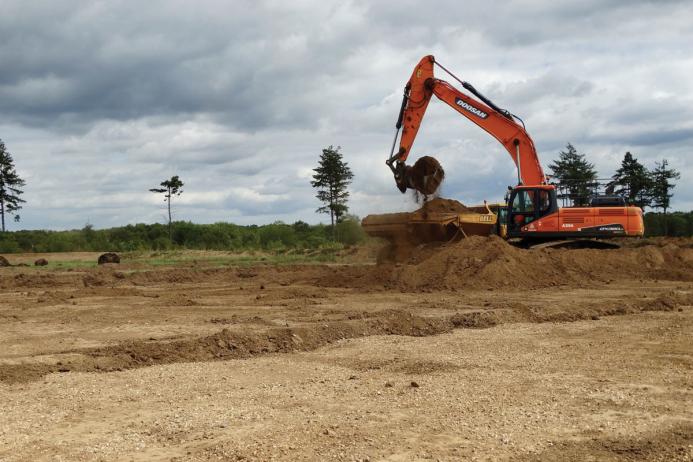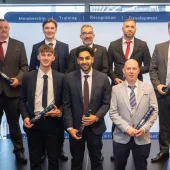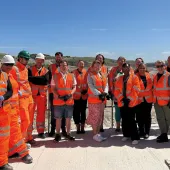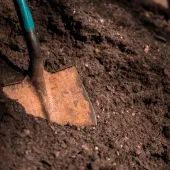Safeguarding Soil Resources

First published in the October 2021 issue of Quarry Management
New Good Practice Guide for Handling Soils in Mineral Workings
The focus of current UK Government policy in England, as set out in its 25 Year Environmental Plan (Defra, 2018), is to safeguard all soil resources (as Natural Capital, Defra, 2021). These policies are to be followed by the mineral extraction industry and regulated by the planning authorities. By 2030 all soils are to be managed sustainably.
The Institute of Quarrying (IQ), Natural England and the Welsh Government, with the support and guidance of a steering group representing the minerals industry, mineral planning authorities, contractors, professional bodies, and specialist consultants, have undertaken a timely update to the MAFF* ‘Good Practice for Handling Soils’ document, originally published in 2000.
The updated publication, ‘Good Practice Guide for Handling Soils in Mineral Workings’, succeeds ‘Good Practice for Handling Soils’ and is designed specifically to help the mineral industry and its contractors to achieve a good standard of agricultural restoration when using various combinations of earthmoving machinery for soil stripping, storage, and replacement.
James Thorne, chief executive officer of the Institute of Quarrying, says: ‘With the recent changes in land use and environmental-related policies, it is appropriate that the guidance is updated and expanded to include these. Attention is rightly focused on soil Natural Capital to ensure that the natural resource is left in a measurably better state than beforehand.
‘Environmentally positive policies are increasingly driving operational practices, and as the professional membership body for the quarrying and aggregates sector, the Institute believes it is critical to provide current guidance that supports better performance outcomes for the industry.’
In addressing the new Natural Capital-driven policies for the protection of soil resources and their sustainable management, soil compaction and its associated limitations on soil functions has long been known to be the main adverse effect of handling and trafficking soils with earthmoving machines.
It remains the primary challenge for successfully achieving the intended after-uses and the maintenance provision of defined environment and ecosystem services, and the associated soil functions associated with healthy soils. Whilst the occurrence and degree of compaction are related to the choice of machinery combination and handling practice, they are also a function of both the type of soil and the wetness of the soil at the time of handling.
The prime aim of the guidance is to minimize the compaction of soils as they are handled, with minimal reliance on the need for remedial treatment of compaction caused by the machinery and handling practices. The updated guidance places greater attention on the wetness of soils during handling operations. It is aimed primarily at managers of quarry operations, mineral planners, restoration specialists, consultants, and earthmoving contractors, but its guidance and applications also extend to the civil engineering and wider construction sectors.
Julian Smallshaw, head of education and standards at IQ, says: ‘The Institute has been able to bring together all facets of the industry to help peer review this valuable work. It has taken over three years to get to this point and much time and effort by all involved. This resource will be a ‘must have’ for anyone involved in soil handling on mineral extraction sites. We will be incorporating this guidance in our own educational and training materials as part of our commitment to ensure learning is aligned with current best practices in the industry.’
Dr Neil Humphries FIQ, author of both the original and the updated guidance, says: ‘I am very pleased that the Institute has taken on this initiative and that it will become part of its educational programme. Importantly, it now integrates the role and contribution of professional soil scientists in the deployment of good operational practice by way of a Soil Resource & Management Plan. This should be the primary reference material for characterizing the soil resources available, informing and successfully delivering the intended after-use(s), whether agricultural, horticultural, forestry, semi-natural vegetation/ecosystems, or other soil-based ones. It will underpin the operational design, land use, and landscaping plan, the practices needed to be deployed, and the means of communication to all those involved. The importance of competency in the technical understanding of soils and the implications of the operational practices are also emphasized.’
The guidance is in two parts. Part one is an introduction to soils and good handling practices. The familiar MAFF presentation of the model methods as individual ‘sheets’ has been retained in part two of the new publication for everyday communication to all levels of users. Model methods are provided for the two widely used machinery combinations of excavators and dumptrucks, and bulldozer and dumptrucks. Model methods are provided for the three most commonly used soil-handling practices (the ‘bed/strip’, the ‘windrow/peninsular’ and the layer by layer). A method for an alternative ‘loose-tipping’ approach (using excavators for the subsoil and bulldozer for the topsoil) is a new addition.
The new guidance, ‘Good Practice Guide for Handling Soils in Mineral Workings’, is available as a free PDF download from the IQ website. The total number of pages is 162 but these can be easily navigated through hyperlinks. The individual practical applications (comprising 15 practical application guidance notes, titled Sheet A to Sheet O) can also be downloaded as separate PDFs from the same location.
Now that the process of updating the guidance is complete, the steering group is keen for users of the guidance to provide ongoing feedback to inform future guidance. A feedback questionnaire is provided on the landing page where the documents can be accessed. For more information or to download the updated guidance, visit: www.quarrying.org/soils-guidance
* MAFF is the former Ministry of Agriculture, Fisheries and Food, now absorbed into Defra (The Department for Environment, Food and Rural Affairs).
- Subscribe to Quarry Management, the monthly journal for the mineral products industry, to read articles before they appear on Agg-Net.com








